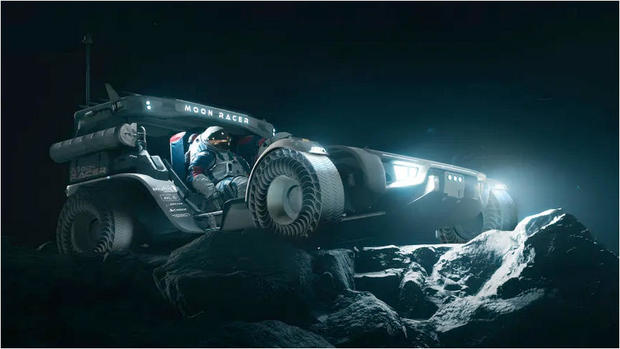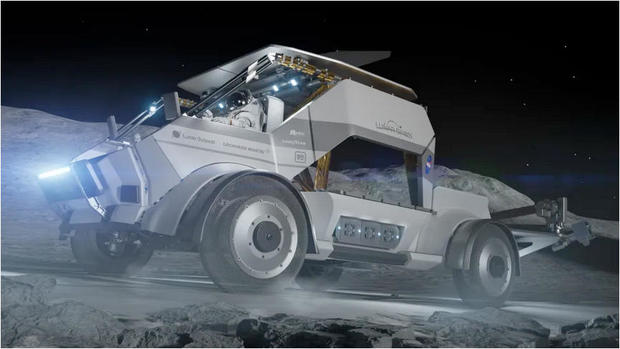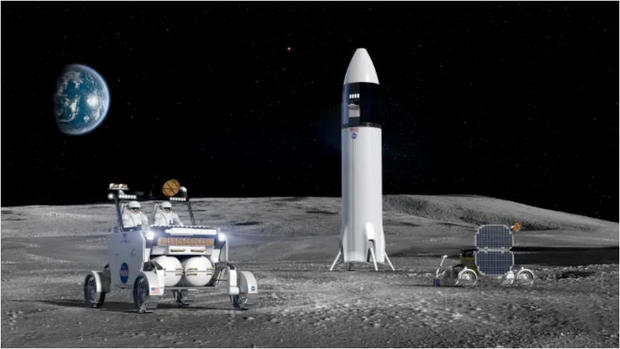
3 companies win NASA contracts to develop new Artemis moon rover designs
Along with funding the commercial development of new rockets, Artemis moon landers and new spacesuits, NASA is pressing ahead with plans to buy an unpressurized moon rover that can carry astronauts, science payloads — or both — across the rugged terrain of the lunar south pole, officials said Wednesday.
The agency announced contract awards to three companies to develop competing designs for a Lunar Terrain Vehicle, or LTV, similar in concept to the rovers that carried the last three Apollo crews across the moon’s surface more than 50 years ago.
Intuitive Machines
But the new models will feature state-of-the-art technology, long-lasting tires, autonomous computer control and other technology upgrades, allowing them to cover much greater distances under manual astronaut control or by remote control from Earth.
during our Artemis missions, they’ll be able to go farther and conduct more science than ever before thanks to the Lunar Terrain Vehicle,” said Vanessa Wyche, director of the Johnson Space Center. “Think of a hybrid of the Apollo style lunar rover … and an uncrewed mobile science platform.”
“This will give the crew the capability to travel a distance much further from their landing sites,” Wyche said. “In addition, during uncrewed operations, the LTV will provide autonomous operations for science and technology.”
Lunar Outpost
The milestone-based Lunar Terrain Vehicle Services contract has a maximum value of $4.6 billion. But NASA is starting out small, doling out three “feasibility” contracts to Intuitive Machines of Houston, Lunar Outpost of Golden, Colorado, and Venturi Astrolab of Hawthorne, California.
The companies will spend the next 12 months perfecting their designs and developing plans for getting their rovers to the moon. At that point, NASA will conduct a formal competition and choose a single contractor to proceed with actual development.
The goal is to have a working rover waiting on the moon when astronauts making the third Artemis moon landing reach the lunar south pole later this decade.
Company representatives, citing the competitive nature of the project, declined to provide details on what sort of range their rovers might achieve, whether they will use solar panels or how long a rover might last.
Venturi Astrolab
But Jaret Matthews of Astrolab said NASA’s initial requirements “are that it travel 15 kilometers an hour, that it be able to traverse 20 kilometers on a charge and be able to support a full eight-hour EVA [moonwalk]. Those are the base-level requirements. It’s our intention to exceed those by quite a lot in most instances.”
Whatever the specifics, the unforgiving environment of the lunar south pole will pose a major challenge. Steve Altemus, CEO of Intuitive Machines, said his company is working with Boeing, Michelin and Northrop Grumman to develop its LTV.
“We’re going to need this world-class team to do that because … the environment on the moon is harsh,” Altemus said. “We have 500 degree temperature swings. The south pole region is rocky and craggy and shadowed. It’s going to stress our suspension, our drivetrain, our power systems, and our autonomous driving algorithms and software.”
“We’re going to need this globally integrated team to pull that off, to allow this rover to live for 10 years and provide the service that NASA’s asking for,” he added.
The other competitors are partnering with major aerospace companies as well, and all three are confident they can meet the challenge.
So is NASA.
“We are combining the best of human and robotic exploration,” said Jacob Bleacher, a planetary geologist who serves as NASA’s chief exploration scientist. “Between the Artemis missions, when our astronauts are not on the moon, NASA can use the LTV’s remote operation capabilities to continue exploring.
“The LTV is truly an exploration vehicle,” he said. “Where it will go, there are no roads. Its mobility will fundamentally change our view of the moon.”
NASA’s long-range plans for Artemis also include a pressurized rover that could carry astronauts over much longer distances and provide a more comfortable environment for long-duration exploration. Toyota is working on a pressurized rover concept, but NASA has not released details about how that vehicle might fit into the Artemis architecture.
More
More
Source: cbsnews.com

